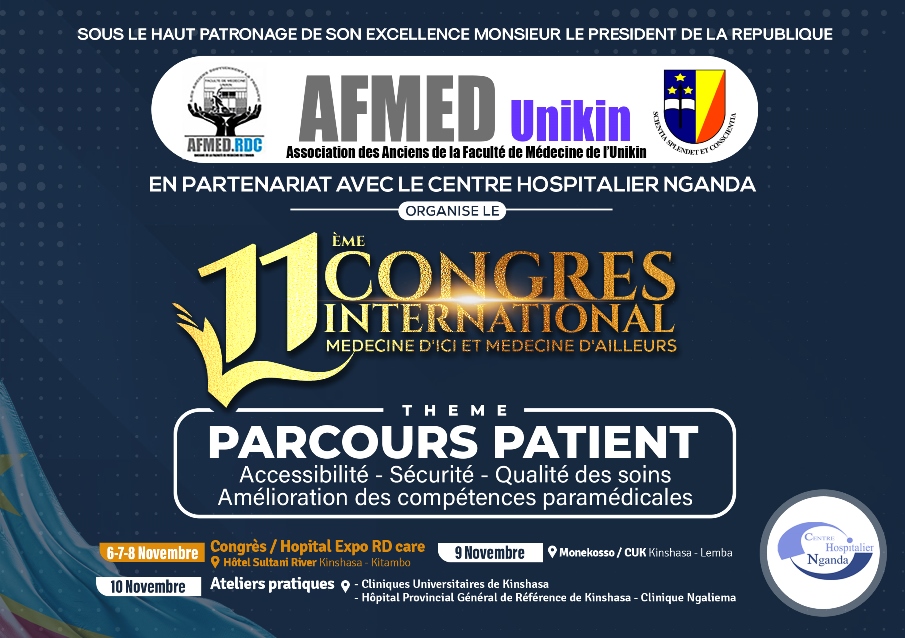Par
EKILA IFINJI Richard
Docteur en Médecine
Mémoire présenté et défendu en vue de l’obtention du titre de spécialiste en Biologie médicale.
Option: Microbiologie
================
Contexte : La tuberculose reste un fléau mondial. En République Démocratique du Congo (RDC), le Ziehl-Neelsen (ZN) demeure l’outil diagnostic le plus utilisé pour la détection du Mycobacterium tuberculosis là où la biologie moléculaire n’est pas disponible.
Différentes interventions dont la vidéo d’instructions du prélèvement des expectorations peuvent améliorer la qualité du crachat ainsi que le taux de positivité du ZN.
L’objectif de cette étude était d’évaluer l’efficacité de la vidéo expliquant la manière appropriée de collecter le crachat pour le diagnostic de la tuberculose.
Matériel et Méthodes : Il s’agit d’un essai contrôlé randomisé, multicentrique, à simple aveugle et mené dans les CSDT de Mbandaka.
Des patients présumés tuberculeux, consentant, ont été assignés au hasard soit au groupe intervention, soit au groupe contrôle.
Chez tout patient inclus, des crachats ont été collectés.
La qualité de crachat a été évaluée par l’aspect et le volume et ensuite une coloration de ZN a été réalisée.
Résultats : Au total, 175 présumés tuberculeux ont été inclus dans cette étude dont 89 dans le groupe intervention et 86 dans le groupe contrôle.
L’âge moyen était de 41,7 ± 16,4 ans. Dans les deux échantillons (contact et matin), le taux de frottis positif était très significatif dans le groupe intervention vs groupe contrôle avec 58,43% vs 29,07% (p < 0,0001) crachat contact et 59,55% vs 36,05% (p = 0,002) crachat matin.
La densité bacillaire était très significatif dans les crachats du groupe vidéo vs groupe contrôle (exemple 31,41 % vs 11,61%, p=0,002 pour les contacts et 30,34% vs 15,12%, p=0,025 pour les matins).
L’aspect mucopurulent et le volume 2: 3 ml étaient significatifs dans le groupe intervention vs groupe contrôle avec 86,52% vs 66,28% (p=0,002) pour l’aspect contact et 80,90 % vs 58,14 % (p=O,OOl) pour le volume matin.
L’appartenance au groupe intervention a amélioré la qualité du crachat, OR 3,05; IC 95 % (l,54 – 6.02), p=O,OOl pour le volume 2:3 ml et OR 3,42; IC 95 % (1,53 – 7.64), p=0,003 pour l’aspect mucopurulent.
La positivité était associée à l’aspect mucopurulent dans le groupe intervention avec 67,09% (p<O,OOOl).
Conclusion : Cette étude a montré que la vidéo d’instructions améliore la qualité des expectorations ainsi que le taux de positivité dans les CSDT de Mbandaka.
Mots clés : Mbandaka, Vidéo d’instructions, Tuberculose, Ziehl-Neelsen.
Background : Tuberculosis remains a global scourge.
In the Democratie Republic of Congo (DRC), Ziehl-Neelsen (ZN) remains the most used diagnostic tool for the detection of Mycobacterium tuberculosis where molecular biology is not available.
Various interventions including the instructional video for sputum collection can improve sputum quality as weil as the ZN positivity rate.
The objective of this study was to evaluate the effectiveness of the video explaining the appropriate way to collect sputum for the diagnosis of tuberculosis.
Material and Methods: This is a randomized, multicenter, single-blind, controlled trial conducted in the CSDTs of Mbandaka.
Consenting presumptive TB patients were randomly assigned to either the intervention group or the control group.
In ail patients included, sputum was collected. Sputum quality was assessed by appearance and volume and then ZN staining was performed.
Results : A total of 175 suspected tuberculosis patients were included in this study, including 89 in the intervention group and 86 in the control group.
The mean age was 41.7 ± 16.4 years.
In both samples (contact and moming), the positive smear rate was very significant in the intervention group vs control group with 58.43% vs 29.07% (p < 0.0001) contact sputum and 59.55% vs 36.05% (p = 0.002) moming sputum.
The bacillary density was very significant in the sputum of the video group vs control group (example 31.41% vs 11.61%, p=0.002 for contacts and 30.34% vs 15.12%, p=0.025 for momings ).
The mucopurulent aspect and the volume > 3 ml were significant in the intervention group vs the control group with 86.52% vs 66.28% (p=0.002) for the contact aspect and 80.90% vs 58.14% ( p=O.OOI)for the moming volume.
Belonging to the intervention group improved sputum qua lity, OR 3.05; 95% CI (1.54 – 6.02), p=O.OOIfor volume 3ml and OR 3.42; 95% CI (1.53 – 7.64), p=0.003 for the mucopurulent aspect.
The positivity wasassociated with the mucopurulent aspect in the intervention group with 67.09% (p<O.OOOI).
Conclusion : This study showed that the instructional video improves the quality of sputum as weil as the positivity rate in the CSDTs of Mbandaka.
Keywords: Mbandaka, instructional Video, Tuberculosis, Ziehl-Neelsen.









